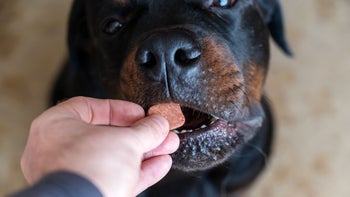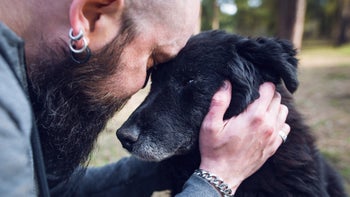
Can Dogs Eat Peaches? Yes, But Skip the Pits
Key takeaways:
Fresh peaches make a delicious and nutritious summer treat for humans and dogs alike.
Peaches are loaded with nutrients like fiber and antioxidants that can benefit a dog’s health.
But peach pits contain a cyanide compound, amygdalin, that can make your dog sick. Throw out the pit before giving your dog peach slices.
Table of contents

Summer means fresh peaches. We slice them up for cobblers, salads, and homemade ice cream. If you’re a dog owner, you may wonder if you can share peaches with your pup.
Turns out, peaches make a nutritional treat for our furry friends too. But there are some precautions you need to take. Peach pits are harmful, even toxic, to dogs.
Here’s what you need to know before you slice up a peach for your pooch.
Search and compare options
Can dogs eat peaches?
Yes, dogs can eat peaches. They contain nutrients that are beneficial for dogs. They’re low in calories and have no saturated fats. They are also packed with vitamins, minerals, and antioxidants.
But peach pits contain amygdalin, a cyanide compound that is toxic to dogs. Make sure you throw away the pit before sharing a peach with your fur baby.
How do you prepare peaches for dogs?
The best way to serve your dogs peaches is in small slices or cubes. Follow these steps to get your peaches pup-ready:
Wash the outside of the peach.
Peel skin off or leave it on.
Throw out the pit.
Cut into small cubes or thin slices.
Frozen peach slices are also a cool dog treat. Serve in a pup cup with other dog-friendly frozen fruits like blueberries.
Avoid canned and dried peaches and peach jams and jellies. They contain a lot of sugar and other ingredients that may not be good for dogs.
How many peaches can a dog have in a day?
How many peaches your dog can have depends on their size and daily treat calorie allowance. Think of peaches as a treat for your dog and not a meal replacement. Treats should make up only 10% of your dog’s daily calories. A quarter cup of sliced raw peaches with peel provides around 18 calories.
Unsafe foods for dogs: Peaches may be safe for your pup, but many human foods aren’t. Brush up on your food-safety knowledge to keep your dog safe.
Think your dog ate something poisonous? Call a pet poison hotline for advice on what to do next.
Dog vomiting: There are many reasons a dog may vomit. Learn some of the most common ones and when it’s time to call for veterinary help.
Using a canine calorie calculator, we put together this chart to guide you on the maximum amount of peaches your dog can have in a day.
Dog breed | Average weight | Calories per day | Peach serving |
|---|---|---|---|
Chihuahua | 5 lbs | 180 | ¼ cup |
Beagle | 20 lbs | 510 | ¾ cup |
Springer spaniel | 50 lbs | 1,020 | 1 ½ cups |
Weimaraner | 80 lbs | 1,450 | 2 cups |
Bullmastiff | 120 lbs | 1,960 | 2 ½ cups |
Remember, the amounts above reflect a dog’s maximum treat allowance per day. If you give your dog other treats, scale back their peach slices.
Antje Joslin, DVM, a veterinary consultant for Dogtopia, recommends starting small with peaches for your dog.
“Fruits and veggies are good for dogs, but they have a lot of sugar, especially fruit,” she told GoodRx Health. “It’s fine to incorporate a little bit into the diet to give variety and add some vitamins and fiber.”
Plus, you don’t know how your dog’s body is going to respond. The maximum amount of peaches could cause diarrhea, for instance. Start with a thin peach slice and go up from there.
What are the benefits and risks of feeding a dog peaches?
Peaches have many nutrients that benefit human health. Joslin said these nutrients benefit dogs as well. But feeding your dog peaches also comes with risks. It’s important to be aware of these and take precautions.
Benefits
Peaches have a number of potential benefits for dogs, including:
Low in calories: Small servings of peaches may curb obesity in dogs.
No saturated fats: Foods with no saturated fats can protect against heart disease.
Fiber: A diet rich in fiber can help your dog poop regularly.
Antioxidants: Foods with antioxidants guard against cancer and other diseases.
Vitamin C: Fruits high in vitamin C can build resistance against infections.
Risks
Peach pits can cause problems in dogs. They contain a type of cyanide that, when consumed in large amounts, can make your dog sick. Peaches can also choke your dog or block their digestive system.
Other parts of a peach, like the stems and leaves, can also make your dog sick.
Feed your dog the flesh only, with or without the skin.
What other fruits are safe for dogs to eat?
Many fruits are safe for dogs to eat in moderation. These include:
Bananas
Blueberries
Cantaloupe
Honeydew melon
Oranges
Pears
Plums
Raspberries
Strawberries
Tangerines
Watermelon
Frequently asked questions
Yes, certain fruits are toxic to dogs. Do not feed your dog:
Apricots
Cherries
Star fruit
Tomatoes
Wild berries
Yes, peach pits are poisonous to dogs. They contain amygdalin, a cyanide compound that can make your dog very sick.
Yes, dogs can eat peaches with skin. Joslin said, “Every dog is different, but there’s nothing in peach skin that’s problematic.”
The bottom line
Peaches are loved by both humans and dogs. They’re full of nutrients, such as fiber and vitamin C, that can boost your dog’s health. But you’ll want to throw out the peach pits because they are toxic to dogs.
Give your dog up to 10% of their calories in treats like peaches. A tiny dog could get up to ¼ cup of peaches a day, while a giant breed could eat 2 ½ cups. Start small, and scale back if you give your dog other treats.
Just because peaches are safe doesn’t mean all fruits are OK for dogs. Apricots, grapes, and tomatoes can make your dog sick. On the other hand, apples, cantaloupe, and plums are healthy for dogs.
Why trust our experts?



References
American Society for the Prevention of Cruelty to Animals. (n.d.). Peach.
Ensle, K. (2015). Health benefits of peaches: A delicious summer fruit. New Jersey Agricultural Experiment Station, Rutgers.
Gwaltney-Brant, S. M., et al. (2025). Food hazards. Merck Veterinary Manual.
Keller, N. (2014). Household toxins: Dogs and cats. World Small Animal Veterinary Association World Congress Proceedings.
Tanprasertsuk, J., et al. (2021). Roles of plant‐based ingredients and phytonutrients in canine nutrition and health. Journal of Animal Physiology and Animal Nutrition.
University of California Davis Veterinary Medicine. (n.d.). Treat guidelines for dogs.
U.S. Food and Drug Administration. (2023). Potentially dangerous items for your pet.

























